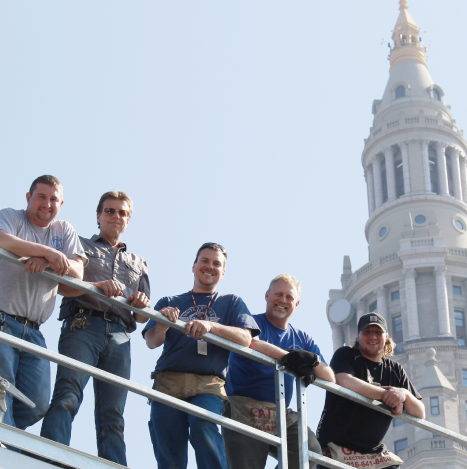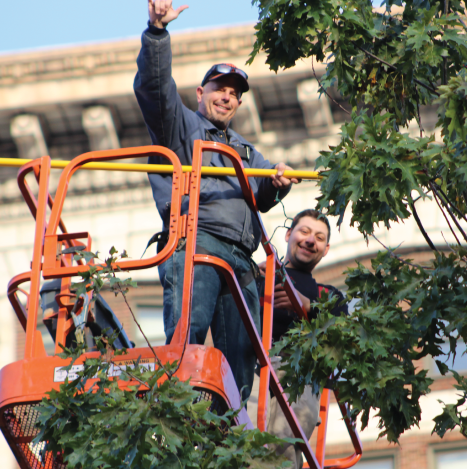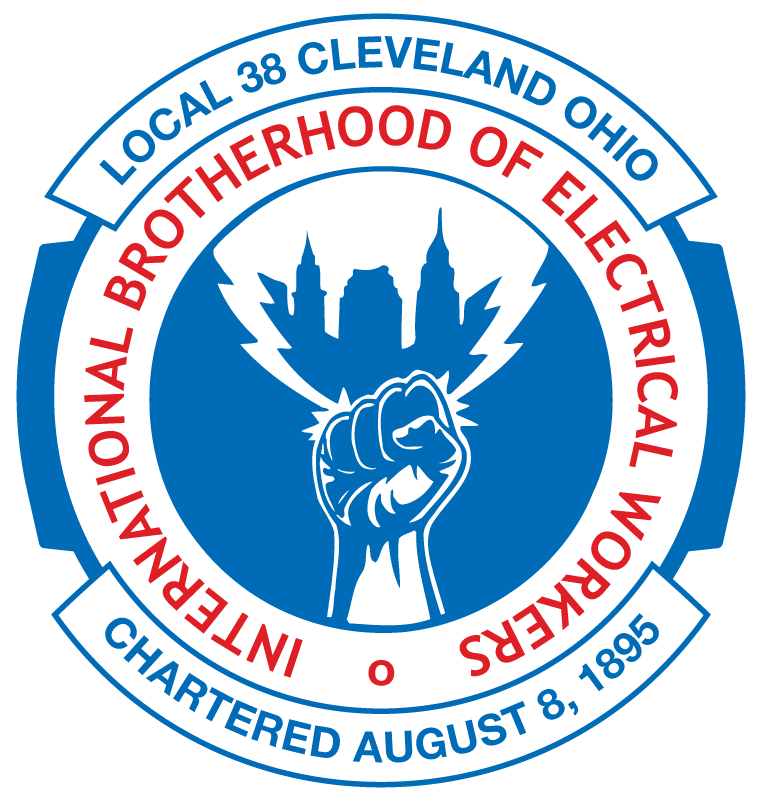
In The Beginning
IBEW Local 38 History
Cleveland was a hub of electrical energy in the late 19th century.
The city’s first telegraph line in 1847 and telephone in 1877 made instant communication possible. Electrical lighting in 1879 transformed Cleveland, and the entire country, into a “day and night” society drawing a need for experts who could install and keep these modern day conveniences up and running. The country’s first electric railway began its journey in Cleveland in 1884 and brought more than 50,000 workers into the city each day.
By 1890, commercial applications of electricity were energizing the city with new building and manufacturing projects, as construction companies relied on the expert craftsmanship of wiremen and fixturemen to safely wire buildings and install equipment and fixtures.
Over one million skilled and unskilled workers had entered the electrical trade nationally. In 1890, electrical workers traveled from all over the country to wire the new electrical “wonders” of the century at the St. Louis Exposition. As workers gathered to talk during breaks, they discussed the state of their trade. They complained about low wages, dangerous working conditions and untrained workers who lowered the reputation of skilled workers. The men realized the electrical trade would not be able to demand higher wages without some type of organization, which could develop new standards of safe practices, training and quality workmanship.
The National Brotherhood of Electrical Workers (NBEW) was organized in a room over Stolley’s Dance Hall in 1891 as a precursor to the International Brotherhood of Electrical Workers (IBEW). A week later, it received a charter and jurisdiction over all electrical work at the American Federation of Labor Annual Convention.
In 1892, the representatives from the Brotherhood arrived in Cleveland. Local 16 was chartered and the new Cleveland Local hosted the NBEW third’s convention 1893.
The financial “Panic of 1893” caused a four-year economic depression. Industry stopped growing and investment in the electrical industry came to a standstill. Many electrical companies folded and General Electric was pushed to the brink of bankruptcy. Unfortunately, Local 16 folded that same year.
Economic growth eventually rekindled in Cleveland, as 19 linemen became charter members of Local 38 on August 8, 1895. This marked a new beginning for the NBEW in Cleveland, as Local 38 led the nation in negotiations for an eight-hour day, wage increases and new standards for apprenticeship training.
By 1899, the inside wiremen began to outnumber the outside lineman in Local 38. It became clear to the membership the needs of inside wiremen and outside electrical workers were different. The inside wiremen performed different handwork, which required a different type of apprenticeship program. In order to resolve this issue, IBEW Local 39 was chartered in 1899 as Cleveland’s outside lineman Local. Thus, Local 38 became an inside Local.
The Turn of the Century
IBEW Local 38 History
Commercial activity carried into the turn of the 20th century, with the construction of the Caxton, Rose, Williamson, Schofield, Citizens, Rockefeller and Cleveland Athletic Club buildings.
In the early days of Local 38, there was little inside electrical work. The Old Stone Church on Public Square was the first building to be wired for incandescent lighting, but soon, other buildings followed suit.
The “Roaring Twenties” were a time of heavy industrial expansion, and Local 38 was in the thick of it, providing highly skilled electricians for such projects as the Public Auditorium, the main branch of the Cleveland Public Library and the Music Hall. Wiring was also needed for the new Playhouse Square district, which boasted live and motion picture theaters.
In 1923, ground broke for the largest building project in the city’s history – the Cleveland Union Terminal Complex and the Terminal Tower. Covering 17 acres, “the Depot Job” employed scores of electricians, who installed the power, which would make 85 modern street lamps glow.
A few years later, the stock market crash and the Great Depression halted Cleveland’s massive building boom. It was not until the Great Lakes Exposition of 1936-37 that the weariness of the Depression began to lift and electricians went back to work. Constructed along the lakefront, the expo was a celebration of industry and featured Cleveland as a center of lighting research.
Lewis Doehring was an apprentice at the time.
“I remember getting 50 cents an hour on that job,” he said. “I spent three months of the time digging ditches for the underground cable we had to lay.”
The massive Republic Steel project provided jobs for hundreds of electricians, as they built a new continuous strip mill.


1940 – Present Day
IBEW Local 38 History
While World War II took many men away from home, the war effort created a great industrial boom to meet the demand for war machinery such as planes, tanks, trucks and artillery. In 1941, the government ordered the construction of a bomber plant in Brook Park, which today as the I.X. Center.
In 1943, the National Advisory Committee for Aeronautics (NACA) constructed a $20 million aircraft engine research laboratory. Later named the NASA Lewis Research Center, it supplied countless man hours for members of IBEW Local 38.
The 1950’s saw expansion of the auto industry and therefore plenty of work for Local 38. Ford Motor Company began the first phase of a mammoth plant in Brook Park. Meanwhile, the electrical systems of Cleveland’s downtown were switched from DC to AC to meet the rising demand for power.
The 1960’s and early 1970’s brought the Erieview plan, one of the nation’s most ambitious urban-renewal projects. The buildings constructed included Erieview Plaza, the Federal building, AECOM building, Park Center and the Public Utilities building. IBEW Local 38 members were involved in the construction of these buildings from the ground up.
With the exception of the National City Bank building, there was little construction in downtown Cleveland in the mid to late 70s. However the construction outside of the city limits, including The Davis Besse Nuclear Power Station to the west and the Perry Nuclear Power Plant to the east. The construction of Ohio’s two nuclear power plants provided Local 38 members with jobs well into the 1980’s.
During the 1980’s, construction began to rebound and Cleveland’s skyline once again underwent dramatic change. Major projects such as the PNC Center, 200 Public Square, the AT&T building, Medical Mutual, North Point and The Galleria kept Local 38 members working.
As the 20th century gave way to the 21st century, downtown Cleveland began to transform into a dynamic metropolis, and IBEW Local 38 had a hand in most of it. Local 38 members proudly sparked life into the city with projects including Tower City, Key Tower, the Ritz-Carlton, Marriott Hotel, Wyndham Hotel, Progressive Field, Rocket Mortgage FieldHouse, the Rock and Roll Hall of Fame, Great Lakes Science Center, the Global Center for Health Innovation and Convention Center, the East Bank of the Flats, Cleveland Aquarium, Jack Casino and a multitude of new apartments.
